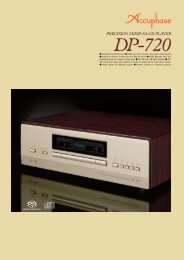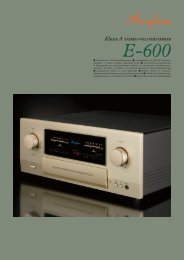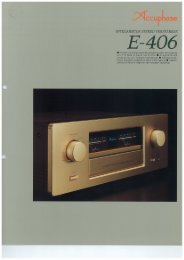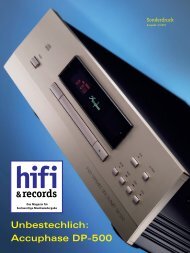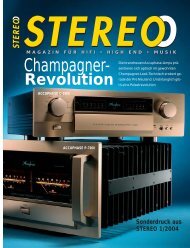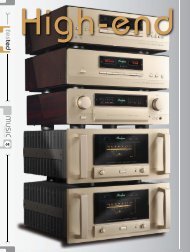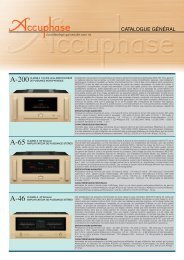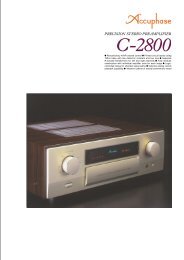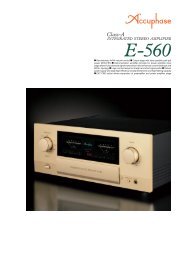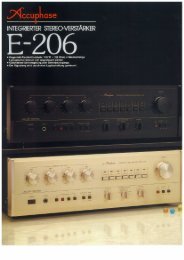m Revolutionary AAVA volume control m Fully modular ... - Accuphase
m Revolutionary AAVA volume control m Fully modular ... - Accuphase
m Revolutionary AAVA volume control m Fully modular ... - Accuphase
Create successful ePaper yourself
Turn your PDF publications into a flip-book with our unique Google optimized e-Paper software.
m <strong>Revolutionary</strong> <strong>AAVA</strong> <strong>volume</strong> <strong>control</strong> m <strong>Fully</strong> <strong>modular</strong> construction<br />
with individual left/right amplifi er units m Separate R-toroidal power<br />
transformers for left and right channels m Selectable preamp gain<br />
m Printed circuit boards made from Tefl on material m Logic-<strong>control</strong>led<br />
relays for shortest signal paths m Optional support for analog<br />
record playback m Massive cabinet made of persimmons wood
The C-2810 inherits the superb design technology<br />
of the C-2800 but takes another signifi cant step forward.<br />
The new model employs only top-quality parts<br />
selected after extended listening tests and features<br />
a further improved <strong>AAVA</strong> (<strong>Accuphase</strong> Analog Varigain<br />
Amplifi er) <strong>volume</strong> <strong>control</strong>. How a preamplifi er<br />
handles listening level adjustment has a decisive<br />
infl uence on its performance and sound. <strong>AAVA</strong> is<br />
an innovative concept that differs radically from<br />
conventional variable-resistor type <strong>volume</strong> <strong>control</strong>s.<br />
In <strong>AAVA</strong>, amplifi cation and <strong>volume</strong> <strong>control</strong> are fully<br />
unifi ed, eliminating all mechanical contact points.<br />
Pure analog processing ensures optimum performance<br />
and superb sound. Another benefi t of <strong>AAVA</strong><br />
is that its performance and sound quality will remain<br />
undiminished for many years to come.<br />
The power supply section of the C-2810 employs<br />
two separate R-toroidal transformers, one for each<br />
channel. Filtering capacitors and all other parts of the<br />
power supply are also duplicated for left and right.<br />
What’s more, all unit amplifi ers such as for input<br />
buffer, <strong>AAVA</strong>, and balanced output are also entirely<br />
separate for the two channels, arranged on a highquality<br />
motherboard. This fully monaural construction<br />
prevents unwanted crosstalk and interaction both on<br />
the electrical and the physical plane. The result is<br />
utterly stable playback sound of impeccable quality.<br />
Logic relay <strong>control</strong> is used for source switching to<br />
implement the shortest possible signal paths. Each<br />
input position allows individual phase selection. The<br />
printed circuit boards are an important element of a<br />
preamplifi er both regarding electrical performance as<br />
well as sound quality. In the C-2810, these are made<br />
from a Tefl on material with low dielectric constant<br />
and minimum loss. Every aspect of this top-notch<br />
analog preamplifi er has been honed for optimum<br />
sonic performance. The overall result is a fl agship<br />
product that represents the best that <strong>Accuphase</strong><br />
has to offer.<br />
INPUT<br />
BUFFER<br />
BUFFER<br />
Input music signal<br />
V- I Converter<br />
Meet the new fl agship model – Preamplifi er with further improved<br />
revolutionary <strong>AAVA</strong> <strong>volume</strong> <strong>control</strong>. Complete dual<br />
mono construction with two R-toroidal power transformers.<br />
Modular amplifi ers using printed circuit boards made from Teflon.<br />
Independent phase selection for each input position. Phono<br />
Equalizer Unit allowing high-quality playback of analog records.<br />
n Logic-<strong>control</strong>led relays assure<br />
high sound quality and<br />
long-term reliability<br />
The strategically placed relays<br />
of the C-2810 prevent any signal<br />
degradation that could occur if<br />
the signal has to travel a long way<br />
for input and output connection<br />
Balanced inputs and outputs Unbalanced inputs and outputs<br />
and function switching. Optimum signal fl ow is maintained at all times.<br />
n Ideal power supply uses “R-toroidal transformers” in fully<br />
monaural confi guration<br />
Each transformer is housed in a dual-wall enclosure with a glass fi ber<br />
core and strong resin coating. In addition, epoxy fi ller with superior<br />
vibration-damping and insulation characteristics is used, resulting in<br />
highly effective triple insulation.<br />
n Printed circuit boards in signal transmission circuitry made<br />
from Tefl on (glass fl uorocarbon resin substrate) with low<br />
dielectric constant and low loss<br />
* Tefl on is a registered trademark of DuPont USA.<br />
n Selectable preamp gain<br />
The overall gain of the preamplifi er can be set to 12 dB, 18 dB, or<br />
24 dB. (Standard position is 18 dB.)<br />
n EXT PRE function allows use of external preamplifi er<br />
n Independent phase selection for each input position<br />
The selected phase setting is memorized for each input position<br />
separately. The on/off status of a LED indicator shows the respective<br />
setting.<br />
n Versatile input and output connectors (inputs shown as<br />
character display)<br />
n Dedicated headphone amplifi er optimized for sound quality<br />
n Versatile features:<br />
m Provisions for recording/playback/copying with two recorders<br />
m Loudness compensator augments bass and treble at low listening<br />
<strong>volume</strong><br />
m Attenuator<br />
m Subsonic fi lter removes ultra low frequency noise<br />
n Massive cabinet made of persimmons wood<br />
CPU<br />
Volume<br />
Balance<br />
Attenuator<br />
I-V Converter<br />
GAIN<br />
VOLUME<br />
5<br />
4 6<br />
3 7<br />
2 8<br />
1 9<br />
MIN MAX<br />
OUTPUT<br />
Response in dB<br />
R-toroidal transformer<br />
Gain selector<br />
EXT PRE function and phase selector button,<br />
with LED indicators<br />
18<br />
16<br />
14<br />
12<br />
LOUDNESS COMPENSATOR: ON<br />
10<br />
COMP.2<br />
8<br />
6<br />
COMP.1<br />
4<br />
COMP.2<br />
2<br />
0<br />
COMP.1<br />
-2<br />
-4<br />
-6<br />
10 100 1k 10k 100k<br />
Frequency in Hz<br />
Loudness compensator characteristics<br />
<strong>AAVA</strong> (<strong>Accuphase</strong> Analog Vari-gain Amplifi er) <strong>volume</strong> <strong>control</strong><br />
Conversion into current with 16<br />
weighting stages (1/2–1/2 16 )<br />
16 current switches (65,536<br />
possible combinations)<br />
CPU detects position of <strong>volume</strong> knob<br />
and operates current on/off switches<br />
according to knob position<br />
Operation principle of <strong>AAVA</strong> in<br />
C-2810<br />
Current<br />
values are<br />
added<br />
Reconversion<br />
of current into<br />
voltage<br />
Volume knob is turned and<br />
position is detected<br />
<strong>AAVA</strong> is a radically different <strong>volume</strong> <strong>control</strong> principle that<br />
does not use variable resistors and provides top-notch<br />
performance and sound quality. Because the music<br />
signal does not pass through variable resistors, it is not<br />
affected by changes in impedance. This means that high<br />
signal-to-noise ratio and low distortion of the signal are<br />
maintained at any <strong>volume</strong> <strong>control</strong> setting.<br />
n <strong>AAVA</strong> resolution<br />
<strong>AAVA</strong> adjusts the listening <strong>volume</strong> by means of 16 weighted V-I<br />
converter amplifi ers which are <strong>control</strong>led by current switches.<br />
The number of possible <strong>volume</strong> steps set by the combination of<br />
these converter amplifi ers is 2 to the power of 16 = 65,536.<br />
n <strong>AAVA</strong> ensures high S/N ratio and uniform frequency<br />
response<br />
With conventional <strong>volume</strong> <strong>control</strong>s, the impedance increases<br />
signifi cantly at settings that correspond to normal listening levels,<br />
thereby leading to increased noise. With <strong>AAVA</strong>, there is no<br />
change in impedance and consequently no deterioration of S/N<br />
ratio. Frequency response also remains totally uniform. Changing<br />
the <strong>volume</strong> with <strong>AAVA</strong> does not mean introducing noise or<br />
detracting from the high performance of the amplifi er.<br />
n No more left/right tracking differences or crosstalk<br />
Because <strong>AAVA</strong> is an electronic circuit employing fixed-value<br />
resistors, there is virtually no left/right tracking error also<br />
at low <strong>volume</strong> levels. Since channels can be kept separate,<br />
crosstalk also does not present a problem.
Input/<strong>volume</strong> level character display <br />
Input display examples<br />
Positions selected with the input selector<br />
and recorder selector are shown as text.<br />
m CD playback<br />
m Tuner playback<br />
m Analog record playback<br />
(with AD-2800 installed)<br />
Recorder playback<br />
Level display examples<br />
When the user operates the <strong>volume</strong> <strong>control</strong>,<br />
the attenuation of the preamplifi er is shown<br />
as an accurate decibel (dB) indication. Other<br />
function switching actions are also indicated.<br />
m Volume <strong>control</strong> at<br />
minimum<br />
m Numeric indication of<br />
<strong>volume</strong> setting<br />
GAIN selector (18 dB)<br />
Balance <strong>control</strong> centered<br />
These indications appear for 4 seconds when the respective function is switched.<br />
n The C-2810 contains a total of 20 unit amplifi ers for the amplifi cation circuitry and<br />
power supply. The printed circuit boards employ Tefl on, and copper surfaces<br />
are gold-plated. The units are completely separate for left and right<br />
channel and housed in solid enclosures made of sturdy 8-mm<br />
thick aluminum. This prevents mutual interference<br />
both in the electrical and mechanical<br />
plane.<br />
n Supplied remote commander<br />
RC-200 provides<br />
access to <strong>volume</strong><br />
<strong>control</strong>, input source selection,<br />
and other functions.<br />
n Simple circuit<br />
confi guration<br />
<strong>AAVA</strong> unifies the<br />
amplifier and <strong>volume</strong> <strong>control</strong> functions, resulting in a circuit that<br />
is electrically very simple. Long-term reliability is excellent, with<br />
performance and sound quality that will remain unchanged also<br />
after prolonged use.<br />
n <strong>AAVA</strong> means analog processing<br />
The <strong>AAVA</strong> circuit converts the music signal from a voltage into a<br />
current, switches gain by means of current switches, and then reconverts<br />
the current into a voltage. The entire process is carried out<br />
in the analog domain.<br />
n Same operation feel as a conventional high-quality<br />
<strong>volume</strong> <strong>control</strong><br />
The <strong>volume</strong> <strong>control</strong> knob position is detected by a dedicated CPU<br />
which in turn selects the current switches for <strong>AAVA</strong> operation. Operating<br />
the knob therefore feels exactly the same as with a conventional<br />
<strong>control</strong>, and as before, operation via the remote commander is also<br />
possible.<br />
n Attenuator and balance <strong>control</strong> also implemented by<br />
<strong>AAVA</strong><br />
The functions of the attenuator and the left/right balance <strong>control</strong> are<br />
covered by the <strong>AAVA</strong> circuit as well, eliminating the need for additional<br />
circuit stages. Keeping the configuration simple helps to maintain high<br />
performance and sonic purity.<br />
The music signal is converted into 16 types of weighted current by V-I (voltage – current)<br />
converting amplifi ers [1/2, 1/22 , ... 1/215 , 1/216 <strong>AAVA</strong> operation principle<br />
]. The 16 currents are turned on or off by 16<br />
current switches, and the combination of switch settings determines the overall <strong>volume</strong>.<br />
The switching operation is <strong>control</strong>led by a CPU according to the position of the <strong>volume</strong><br />
<strong>control</strong> knob. The combined signal current forms a variable gain circuit that adjusts the<br />
<strong>volume</strong>. Finally, the combined current is converted back into a voltage by an I-V (current<br />
– voltage) converter.<br />
The C-2810 contains a total of 20 unit amplifi ers comprising<br />
input buffer, <strong>AAVA</strong> circuitry, balanced output circuitry, power<br />
supply, etc. All are separate for left and right channels.<br />
m C-2810 with optional<br />
Phono Equalizer Unit<br />
AD-2800 installed
Q 3<br />
Q1 MM<br />
MC<br />
Q 5<br />
Q 6<br />
Q 7<br />
Q 8<br />
Q 9<br />
Q 10<br />
Q 11<br />
Q 4<br />
Q2<br />
MM<br />
Q MC<br />
12<br />
Q 13<br />
Q 14<br />
Q 17<br />
Q 15<br />
Q 16<br />
Q 18<br />
Dedicated Phono Equalizer Unit AD-2800<br />
Analog records can be reproduced by installing the dedicated phono equalizer unit AD-2800 in a rear-panel slot. The<br />
AD-2800 uses printed circuit boards made from Tefl on material (glass fl uorocarbon resin substrate) and is housed in<br />
a sturdy aluminum case for complete protection against any external interference. The shortest possible connection<br />
between input and amplifi cation circuits ensures outstanding S/N ratio, and highly reliable DIN connectors are used<br />
for the link to the main unit.<br />
* The AD-2800 can also be used in the <strong>Accuphase</strong> models C-2800, C-2400, C-290 and C-290V.<br />
* The phono equalizer units AD-290 and AD-290V designed for the <strong>Accuphase</strong> models C-290 and C-290V can also be used in the C-2810.<br />
Input<br />
Circuit diagram of phono equalizer unit<br />
AD-2800 (one channel)<br />
n Front Panel<br />
n Rear Panel<br />
Expansion slot<br />
for AD-2800<br />
Input selector<br />
LINE 3 LINE 2 LINE 1 LINE-BAL CD-BAL<br />
CD TUNER AD-1 (OP) AD-2 (OP)<br />
Output selector<br />
EXT PRE ALL BAL UNBAL OFF<br />
Input display<br />
Copy selector 12 OFF 21<br />
Recorder selector<br />
REC OFF SOURCE 1 2<br />
Gain selector 12dB 18dB 24dB<br />
AD gain selector<br />
Level display<br />
Balance <strong>control</strong><br />
Volume <strong>control</strong><br />
Power switch<br />
Phase selector button<br />
Stereo/mono selector button<br />
Display on/off button<br />
Equalizer<br />
elements<br />
+ B<br />
Q 19<br />
Q 20<br />
– B<br />
DC servo amplifi er<br />
Output<br />
Pressing this button<br />
opens the sub panel<br />
Subsonic fi lter<br />
Loudness compensator selector<br />
OFF 1 2<br />
MC impedance selector button<br />
Headphone jack<br />
Attenuator button<br />
Line input connectors<br />
TUNER CD LINE1, 2, 3<br />
Recorder playback/recording connectors<br />
Unbalanced output connectors (2 sets)<br />
External preamplifi er input connectors (unbalanced)<br />
CD/LINE balanced input connectors<br />
Ground Inverted (–)<br />
Non-inverted (+)<br />
Balanced output connectors (2 sets)<br />
External preamplifi er input connectors (balanced)<br />
AC power supply connector <br />
AD-2800 installation<br />
Remarks:<br />
This product is available in versions for 120/230 V AC. Make sure that the voltage shown on the rear panel matches the AC line voltage in your area.<br />
The shape of the AC inlet and plug of the supplied power cord depends on the voltage rating and destination country.<br />
n Supplied accessories:<br />
m AC power cord<br />
m Audio cables with RCA-type plugs (1 m)<br />
m Remote Commander RC-200<br />
m Cleaning cloth<br />
m Specifi cations and design subject to change without notice for improvements.<br />
<br />
http://www.accuphase.com<br />
m MM/MC switching and other function<br />
settings on front panel of C-2810 allow<br />
use of any type of phono cartridge.<br />
AD gain selector MC LOAD selector buttons<br />
C-2810 Guaranteed Specifi cations<br />
Guaranteed specifi cations are measured according to EIA standard RS-490. AD stands for<br />
“Analog Disc”.<br />
Specifi cations are shown for phono equalizer unit AD-2800 installed.<br />
m Frequency Response BALANCED/ UNBALANCED INPUT 3 - 200,000 Hz +0, –3.0 dB<br />
20 - 20,000 Hz +0, –0.2 dB<br />
AD INPUT [MM/36 dB, MC] 20 - 20,000 Hz ±0.2 dB<br />
AD INPUT [MM/30 dB]<br />
m Total Harmonic Distortion 0.005% (for all inputs)<br />
m Input Sensitivity, Input Impedance<br />
20 - 20,000 Hz ±0.3 dB<br />
Input<br />
Sensitivity<br />
For rated output For 0.5 V output<br />
Input impedance<br />
AD:MM/30dB 8.0 mV 2.0 mV 47 kΩ<br />
AD:MM/36dB 4.0 mV 1.0 mV 47 kΩ<br />
AD:MC/62dB 0.2 mV 0.05 mV 10/30/100 Ω, switchable<br />
AD:MC/68dB 0.1 mV 0.025 mV 10/30/100 Ω, switchable<br />
BALANCED/UNBALANCED 252 mV 63 mV 40 kΩ/20 kΩ<br />
m Rated Output Voltage, BALANCED/UNBALANCED OUTPUT: 2 V, 50 Ω<br />
Output Impedance REC (with AD input): 252 mV, 200 Ω<br />
m S/N Ratio (gain selector: 18 dB)<br />
Input<br />
Input shorted, IHF-A weighting<br />
S/N ratio at rated output<br />
S/N ratio (EIA)<br />
AD:MM/30dB 95 dB 91 dB<br />
AD:MM/36dB 89 dB 92 dB<br />
AD:MC/62dB 80 dB 87.5 dB<br />
AD:MC/68dB 75 dB 88.5 dB<br />
BALANCED/ UNBALANCED 111 dB 110 dB<br />
m Maximum Output Level BALANCED/UNBALANCED OUTPUT: 7.0 V<br />
REC (with AD input): 6.0 V<br />
m LINE maximum input level BALANCED/UNBALANCED INPUT: 6.0 V<br />
m Maximum AD Input Level MM [30/36 dB] INPUT: 300 mV/150 mV<br />
(0.005% THD) MC [62/68 dB] INPUT: 7.5 mV/ 3.75 mV<br />
m Minimum Load Impedance BALANCED/UNBALANCED OUTPUT: 600 Ω<br />
REC: 10 kΩ<br />
m Gain (gain selector: 18 dB) BALANCED/ UNBALANCED INPUT BALANCED/UNBALANCED OUTPUT: 18 dB<br />
Gain can be set to 12/18/24 dB UNBALANCED INPUT REC OUTPUT: 0 dB<br />
AD [MM: 30/36 dB] INPUT BALANCED/ UNBALANCED OUTPUT: 48/54 dB<br />
AD [MC: 30/36 dB] INPUT REC OUTPUT: 30/36 dB<br />
AD [MC: 62/68 dB] INPUT BALANCED/ UNBALANCED OUTPUT: 80/86 dB<br />
AD [MC: 62/68 dB] INPUT REC OUTPUT: 62/68 dB<br />
m Loudness Compensation 1: +3 dB (100 Hz) 2: +8 dB (100 Hz) +6 dB (20 kHz)<br />
m Subsonic Filter 10 Hz: –18 dB/octave<br />
m Attenuator –20 dB<br />
m Headphone Jack Suitable impedance: 8 - 100 Ω<br />
m Power Requirements AC 120 V / 230 V, 50/60 Hz (Voltage as indicated on rear panel)<br />
m Power Consumption 43 watts<br />
m Maximum Dimensions Width: 477 mm (18-3/4”)<br />
Height: 156 mm (6-1/8”)<br />
Depth: 412 mm (16-1/4”)<br />
m Mass<br />
(Depth with AD-2800 installed: 414 mm)<br />
21.6 kg (47.6 lbs) net (22.5 kg with AD-2800 installed)<br />
28.0 kg (61.7 lbs) in shipping carton<br />
F0405Y PRINTED IN JAPAN 851-0157-00 (AD1)



